Installing the Blocksi Enterprise Edition Extension
The Blocksi Enterprise Edition (BEE) extension is available on the Google Workspace Marketplace and Chrome Webstore. You install it on the Google Admin console.
Installing the Blocksi BEE is broken into the following three parts:
To add the extension to your Google Admin Console
Sign in to the Google Admin console using your Google Admin credentials.
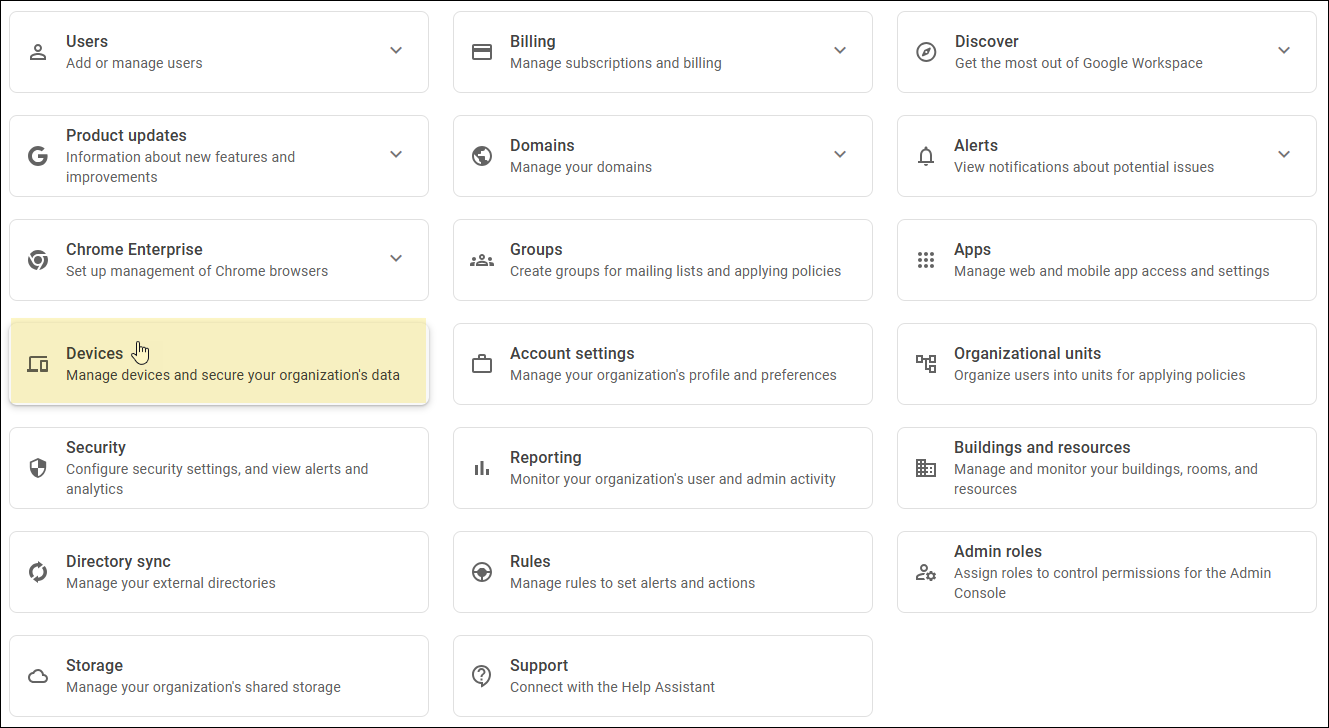
Click Devices.
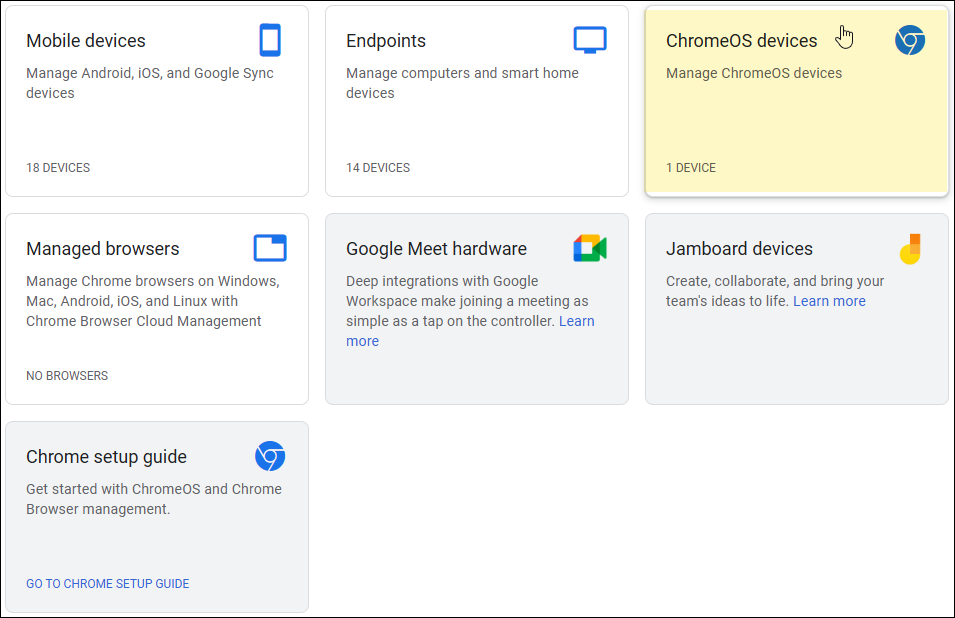
Click ChromeOS devices.
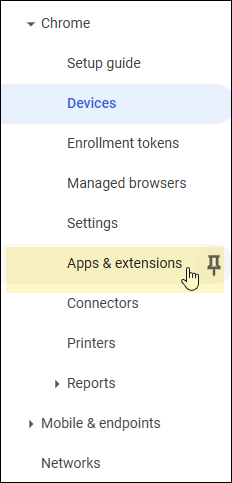
Click Apps & extensions from the Main Menu to the left.

Click the Users & browsers tab. The Users & browsers tab opens.
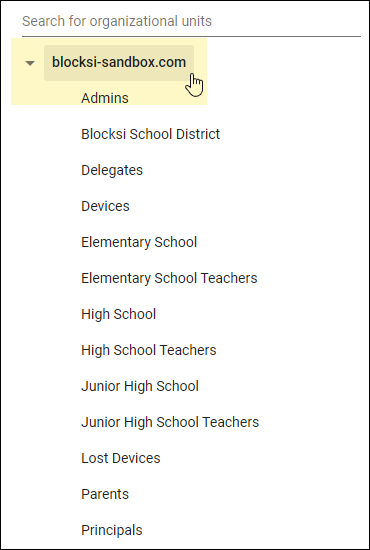
Select and highlight the organizational unit (OU) that contains the users to filter. If your school district intends to filter the entire domain, then you need to highlight the root domain.
Hover your mouse cursor over the
 icon located in the lower right-hand corner of the screen and click the
icon located in the lower right-hand corner of the screen and click the  icon. The Add Chrome app or extension by ID window opens.
icon. The Add Chrome app or extension by ID window opens.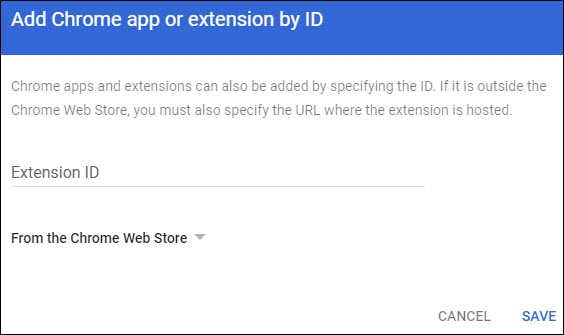
Getting the Blocksi Extension ID
Sign in to the Blocksi Admin Dashboard.

Click the Copy Blocksi Enterprise ID button on the Action Bar of the Admin Dashboard. This copies the Blocksi Enterprise ID to the clipboard.
Return to the Google Admin console and paste the ID into the Extension ID text box.
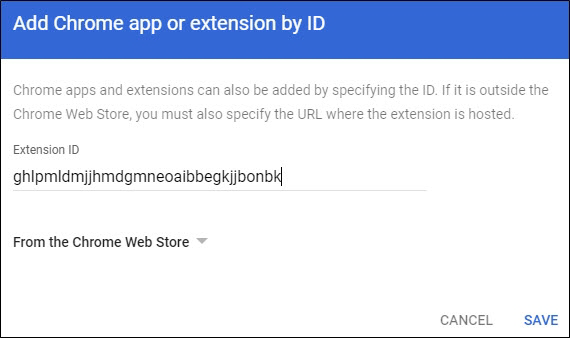
Click Save. The Google Admin console now displays the BEE. By default, the extension is set to Allow install under its Installation policy settings.

Click Allow Install. The Installation policy panel opens to the right.
Click the down arrow to the right of the Allow Install option and switch it to Force Install.

Click SAVE in the upper right-hand corner of the console to save your selection.
To access the Chrome restrictions
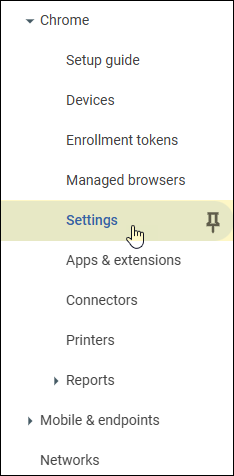
Click Settings from the Main Menu to the left.

Click the User & browser settings tab. The User & browser settings tab opens.
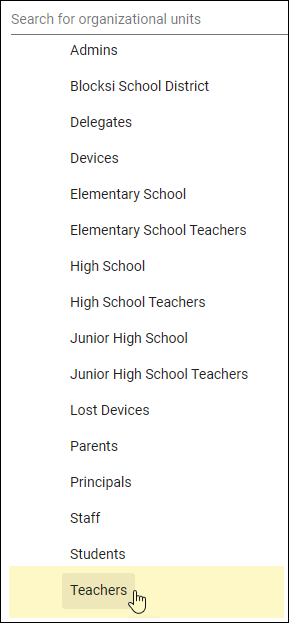
Click the OU with which you plan to monitor students with the Teacher Dashboard. The selection shown here is for example only; yours may be different.
Type screenshot in the + Search or add a filter field and press Enter.
Click the down arrow to the right of the Screenshots option and ensure it is set to Allow users to take screenshots and video recordings. If it is not, then switch it. This enables the capture of screenshots and video recordings of student devices by teachers for monitoring and assessment purposes.
Type screen video capture in the + Search or add a filter field and press Enter.
Click the down arrow to the right of the Screen video capture option and ensure it is set to Allow sites to prompt users to share a video stream of their screen. If it is not, then switch it. Enabling this setting allows teachers and students to share their screens to the Teacher Dashboard or student devices, enhancing collaboration and instructional capabilities.
Click SAVE in the upper right-hand corner of the console to save your selections for this OU.
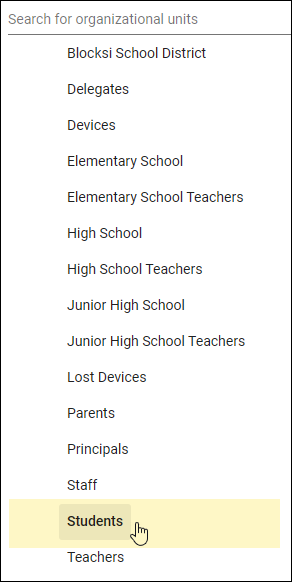
Click the Students OU. You need to prevent students from accessing task manager, incognito mode, and developer tools. The selection shown here is for example only; yours may be different.
To add the restrictions
To add the restrictions
Type task manager in the + Search or add a filter field and press Enter.
Click the down arrow to the right of the Task manager option and switch it to Block users from ending processes with the Chrome task manager. Enabling this setting prevents students from ending the Blocksi extension process through the Chrome Task Manager and gaining temporary unrestricted access.
Type incognito mode in the + Search or add a filter field and press Enter.
Click the down arrow to the right of the Incognito mode option and switch it to Disallow incognito mode. Disallowing Incognito Mode prevents students from disabling extensions, including Blocksi. This ensures that Blocksi can continue to effectively monitor, manage, and filter student activities.
Type developer tools in the + Search or add a filter field and press Enter.
Click the down arrow to the right of the Developer Tools option and switch it to Never allow use of built-in developer tools. By disabling Developer Tools, students are unable to access Chrome Shell (CROSH), a command line interface that offers similar functionality to Linux Bourne Again Shell (BASH) or Windows command terminals. Because CROSH mode grants full access to the Chromebook, restricting this access is vital to upholding the security and effectiveness of the filtering system.
Type URL blocking in the + Search or add a filter field and press Enter.
Click the URL Blocking setting.
Type chrome://extensions in the Blocked URLs section and press Enter.
Type javascript://* in the Blocked URLs section and press Enter.
Type chrome://kill in the Blocked URLs section and press Enter.
Type chrome://hang in the Blocked URLs section and click Save.
Type chrome://flags in the Blocked URLs section and click Save.
To set up the device restrictions

Click the Device Settings tab. The Device settings tab opens.
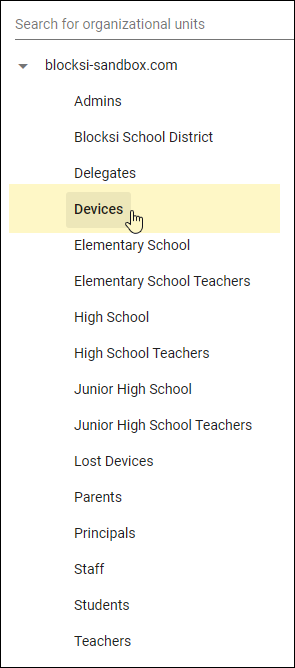
Select the OU in which your schools have their devices enrolled. You need to prevent students from signing in as guest or to other domains.
Type guest mode in the + Search or add a filter field and press Enter.
Click the down arrow to the right of the Guest mode option and switch it to Disable guest mode. Disabling guest mode prevents students from accessing unmanaged sessions on Chromebooks, ensuring that the necessary extensions, including Blocksi, are pushed to their devices.
Type sign-in restriction in the + Search or add a filter field and press Enter.
Click the down arrow to the right of the sign-in restriction option and switch it to Restrict sign-in to a list of users. By allowing specific domains, this setting restricts sign-in to only authorized users, enhancing security and control over Chromebook devices.
Type your domain in the Allowed users field that appears. Remember to include *@ in front of the domain name.
Type autocomplete domain in the + Search or add a filter field and press Enter.
Click the down arrow to the right of the Autocomplete domain option and switch it to Use the domain name, set below, for autocomplete at sign-in.
Type your domain in the username@ field that appears. Entering your domain allows the Chrome browser to prefill the domain for users, simplifying the sign-in process and enhancing user experience.
Type Chrome management for signed-in users in the + Search or add a filter field and press Enter.
Click the down arrow to the right of the Chrome management for signed-in users option and set it to one of the following, depending on your district's requirements:
Apply all user policies when users sign into Chrome, and provide a managed Chrome experience: Selecting this setting pushes all extensions deployed to the user's account when they are on a personal device.
Do not apply any policies when users sign into Chrome. Allow users access to use Chrome as an unmanaged user: Selecting this setting removes any extensions deployed to the user's account when they are on a personal device.
Click SAVE in the upper right-hand corner of the console to save your selections for this OU.
Repeat Parts 2 and 3 for each student organization in your district.